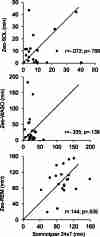Assessment of a wireless headband for automatic sleep scoring
- PMID: 22996794
- PMCID: PMC3655221
- DOI: 10.1007/s11325-012-0757-4
Assessment of a wireless headband for automatic sleep scoring
Abstract
Purpose: Classically, professional assessment of sleep is done in the sleep laboratory using whole-night polysomnography (PSG). However, given a misbalance between accredited sleep laboratories and the large amount of patients suffering from sleep disorders, only few receive appropriate diagnostic assessment. Recently, some low-cost home sleep scoring systems have been proposed, yet such systems are rarely tested scientifically. The aim of the present study was to evaluate the staging accuracy of the home sleep scoring system Zeo (Newton, MA, USA).
Methods: A final sample of 21 nights from ten subjects (aged 23-45) was digitally recorded with PSG as well as with the Zeo system. We compared scorings of Zeo (on an epoch-be-epoch basis) with the Somnolyzer 24 × 7 (an automatic staging algorithm), expert scorers as well as the freeware SleepExplorer.
Results: It was revealed that Zeo shows moderate overall agreement as compared to our study standard Somnolyzer 24 × 7 (κ = 0.56). The most obvious performance difference between Zeo and both other scoring approaches was stage wake (sleep onset latency + wake after sleep onset). While Zeo detected only 40.8 % of the study standard wake epochs, 70.1 % were detected by the expert scorers and 83.4 % by the SleepExplorer, respectively.
Conclusions: Data suggest that the Zeo system produces acceptable sleep scoring for stage REM, light and deep sleep, with a specific weakness in correctly detecting waking periods.
Figures

Similar articles
-
Polysomnographic validation of a wireless dry headband technology for sleep monitoring in healthy young adults.Physiol Behav. 2013 Jun 13;118:185-8. doi: 10.1016/j.physbeh.2013.05.036. Epub 2013 May 26. Physiol Behav. 2013. PMID: 23714587
-
Performance of a Portable Sleep Monitoring Device in Individuals with High Versus Low Sleep Efficiency.J Clin Sleep Med. 2016 Jan;12(1):95-103. doi: 10.5664/jcsm.5404. J Clin Sleep Med. 2016. PMID: 26285110 Free PMC article.
-
Validation of a Wireless, Self-Application, Ambulatory Electroencephalographic Sleep Monitoring Device in Healthy Volunteers.J Clin Sleep Med. 2016 Nov 15;12(11):1443-1451. doi: 10.5664/jcsm.6262. J Clin Sleep Med. 2016. PMID: 27707438 Free PMC article.
-
Automatic sleep classification according to Rechtschaffen and Kales.Conf Proc IEEE Eng Med Biol Soc. 2007;2007:3994-7. doi: 10.1109/IEMBS.2007.4353209. Conf Proc IEEE Eng Med Biol Soc. 2007. PMID: 18002875
-
The Visual Scoring of Sleep in Infants 0 to 2 Months of Age.J Clin Sleep Med. 2016 Mar;12(3):429-45. doi: 10.5664/jcsm.5600. J Clin Sleep Med. 2016. PMID: 26951412 Free PMC article. Review.
Cited by 22 articles
-
REM sleep is associated with white matter integrity in cognitively healthy, older adults.PLoS One. 2020 Jul 9;15(7):e0235395. doi: 10.1371/journal.pone.0235395. eCollection 2020. PLoS One. 2020. PMID: 32645032 Free PMC article.
-
A Protocol for Comparing Dry and Wet EEG Electrodes During Sleep.Front Neurosci. 2020 Jun 17;14:586. doi: 10.3389/fnins.2020.00586. eCollection 2020. Front Neurosci. 2020. PMID: 32625053 Free PMC article.
-
SWS Brain-Wave Music May Improve the Quality of Sleep: An EEG Study.Front Neurosci. 2020 Feb 11;14:67. doi: 10.3389/fnins.2020.00067. eCollection 2020. Front Neurosci. 2020. PMID: 32116514 Free PMC article.
-
Automatic sleep stage classification based on subcutaneous EEG in patients with epilepsy.Biomed Eng Online. 2019 Oct 30;18(1):106. doi: 10.1186/s12938-019-0725-3. Biomed Eng Online. 2019. PMID: 31666082 Free PMC article.
-
Automatic Sleep Staging in Patients With Obstructive Sleep Apnea Using Single-Channel Frontal EEG.J Clin Sleep Med. 2019 Oct 15;15(10):1411-1420. doi: 10.5664/jcsm.7964. J Clin Sleep Med. 2019. PMID: 31596205
References
-
- Iber C, American Academy of Sleep Medicine . The AASM manual for the scoring of sleep and associated events: rules, terminology and technical specifications. Westchester: American Academy of Sleep Medicine; 2007.
-
- Toussaint M, Luthringer R, Schaltenbrand N, Nicolas A, Jacqmin A, Carelli G, Gresser J, Muzet A, Macher JP. Changes in EEG power density during sleep laboratory adaptation. Sleep. 1997;20(12):1201–1207. - PubMed
-
- Montgomery-Downs HE, Insana SP, Bond JA (2012) Movement toward a novel activity monitoring device. Sleep Breath. doi:10.1007/s11325-011-0585-y - PubMed
Publication types
MeSH terms
Grant support
LinkOut - more resources
-
Full Text Sources
-
Other Literature Sources
-
Medical
